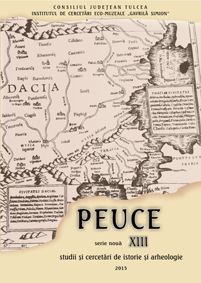Observații asupra osemintelor umane descoperite la „Peștera Craniilor”- Cheile Dobrogei
Comments on the Human Bones Found at „Skulls Cave”- Cheile Dobrogei
Author(s): Mihai ConstantinescuSubject(s): Archaeology, Ancient World
Published by: Institutul de Cercetari Eco-Muzeale Tulcea - Institutul de Istorie si Arheologie
Keywords: Cheile Dobrogei; epoca fierului; epoca romano-bizantină; sacrificii; fracturi; Iron Age; Roman-Byzantine period; sacrifices; fractur
Summary/Abstract: This study deals with the anthropological research of a skull discovered in the Roman-Byzantine layer and a skeleton (Grave 1) dated between the second half of the 7th century and 5th century BC, found at the entrance of the Skulls Cave in Cheile Dobrogei area, Constanța County. Both relics belong to adult female individuals. The analysis shows that the missing segments of the skull from the Roman-Byzantine layer are the result of accidental postmortem damage and not of intentional “cut-out” of the skull base. The skeleton in Grave 1 shows high incidence of caries and dental abscesses, healed fractures of bones from both hands (probably a result of an accidental fall) and a small osteoma on the right parietal bone. Some bones show signs of animal teeth, gaps and cracks that cannot be related to assumed beheading of the individual, but to postmortem interventions. This explains the partial anatomical connection of the skeleton, lack of the long bones of the upper right limb, as well as skull placement over the pelvis separated from the jaw. Grave 1 dating to a time when such discoveries are rare is also under discussion; some funerary ritual elements (placement near a cave, crouched position, presence of ochre etc.) are not specific to Babadag or La Tène period discoveries.
Journal: Peuce (Serie Nouă) - Studii şi cercetari de istorie şi arheologie
- Issue Year: XIII/2015
- Issue No: 13
- Page Range: 209-222
- Page Count: 14
- Language: Romanian

